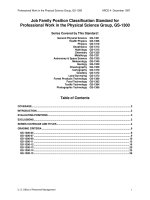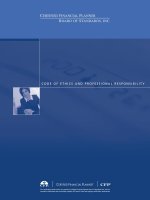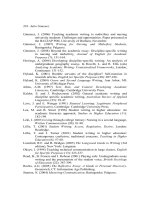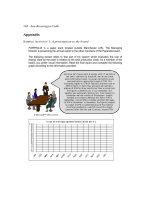Ethics for professional accountants
Bạn đang xem bản rút gọn của tài liệu. Xem và tải ngay bản đầy đủ của tài liệu tại đây (1.36 MB, 71 trang )
Slide 3.1
Ethics for Professional Accountants
Principles of Auditing: An Introduction to
International Standards on Auditing - Ch. 3
Rick Stephan Hayes,
Philip Wallage, and Hans
Gortemaker
[Hayes, Dassen, Schilder and Wallage, Principles of Auditing An Introduction to ISAs, edition 2.1] © Pearson Education Limited 2007
Slide 3.2
WHAT ARE ETHICS?
E A sense of agreement in a society as to what is
right and wrong.
E Ethics represent a set of moral principles, rules
of conduct or values.
– Ethics apply when an individual has to make a
decision from various alternatives regarding
moral principles.
[Hayes, Dassen, Schilder and Wallage, Principles of Auditing An Introduction to ISAs, edition 2.1] © Pearson Education Limited 2007
Slide 3.3
Illustration 3.1
[Hayes, Dassen, Schilder and Wallage, Principles of Auditing An Introduction to ISAs, edition 2.1] © Pearson Education Limited 2007
Slide 3.4
Objectives of Accountantancy Profession
Generally, to meet the public’s interest
“A distinguishing mark of the
accountancy profession is its
acceptance of the responsibility to act
in the public interest. Therefore, a
professional accountant’s responsibility
is not exclusively to satisfy the needs of
an individual client or employer.” Code
of Ethics
[Hayes, Dassen, Schilder and Wallage, Principles of Auditing An Introduction to ISAs, edition 2.1] © Pearson Education Limited 2007
Slide 3.5
PCAOB Ethics – US Classes
• ET Section 100 INDEPENDENCE,
INTEGRITY, AND OBJECTIVITY
• Independence ET Section 101
/>spx
• Integrity and Objectivity ET Section 102
/>US classes
spx
[Hayes, Dassen, Schilder and Wallage, Principles of Auditing An Introduction to ISAs, edition 2.1] © Pearson Education Limited 2007
Slide 3.6
The Code is divided into three parts: A, B,
and C:
• Part A establishes the fundamental principles of
professional ethics for professional accountants and
provides a conceptual framework for applying those
principles.
• Parts B and C illustrate how the conceptual framework is
to be applied in certain situations.
• Part B applies to professional accountants in public
practice.
• Part C applies to professional accountants in
business.
[Hayes, Dassen, Schilder and Wallage, Principles of Auditing An Introduction to ISAs, edition 2.1] © Pearson Education Limited 2007
Slide 3.7
Part A – Fundamental Principles
Part A establishes the fundamental principles of professional ethics
for professional accountants and provides a conceptual
framework that professional accountants shall apply to:
(a) Identify threats to compliance with the fundamental principles;
(b) Evaluate the significance of the threats identified; and
(c) Apply safeguards, when necessary, to eliminate the threats or
reduce them to an acceptable level.
Safeguards are necessary when the threats are not at a
level at which a reasonable and informed third party
would be likely to conclude, weighing all the specific facts
and circumstances available to the professional
accountant at that time, that compliance with the
fundamental principles is not compromised.
[Hayes, Dassen, Schilder and Wallage, Principles of Auditing An Introduction to ISAs, edition 2.1] © Pearson Education Limited 2007
Slide 3.8
Conceptual Framework Approach
• A conceptual framework requires a professional
accountant to identify, evaluate and address threats to
compliance with the fundamental principles, rather than
merely comply with a set of specific rules which may be
arbitrary.
• When an accountant identifies threats to compliance with
the fundamental principles and determines that they are not
at an acceptable level, he/she shall determine whether
appropriate safeguards are available and can be applied to
eliminate the threats or reduce them to an acceptable level.
[Hayes, Dassen, Schilder and Wallage, Principles of Auditing An Introduction to ISAs, edition 2.1] © Pearson Education Limited 2007
Slide 3.9
The IFAC Code of Ethics for Professional Accountants fundamental
principles for ALL Accountants:
1) Integrity (Sec 110)
2) Objectivity (Sec 120)
3) Professional Competence
and Due Care (Sec 130)
4) Confidentiality (Sec 140)
5) Professional Behavior
(Sec 150)
[Hayes, Dassen, Schilder and Wallage, Principles of Auditing An Introduction to ISAs, edition 2.1] © Pearson Education Limited 2007
Slide 3.10
Principles
1) Integrity to be straightforward and honest in
all professional and business relationships.
2) Objectivity: To not allow bias, conflict of
interest or undue influence of others to override
professional or business judgments.
[Hayes, Dassen, Schilder and Wallage, Principles of Auditing An Introduction to ISAs, edition 2.1] © Pearson Education Limited 2007
Slide 3.11
Objectivity
In the auditing sense bias is associated
with money and personal
association, e.g., if possible gains of
wealth, prospects of a better income,
or personal relationships as with
family or friends are involved, this
may bias the auditor’s work. There
exist religious and cultural biases
that may also affect an auditor’s
work and these biases have been
well studied.
[Hayes, Dassen, Schilder and Wallage, Principles of Auditing An Introduction to ISAs, edition 2.1] © Pearson Education Limited 2007
Slide 3.12
Principles
3) Professional Competence and Due Care: to
maintain professional knowledge and skill at the
level required to ensure that a client or employer
receives competent professional service based on
current developments in practice, legislation and
techniques and act diligently and in accordance
with applicable technical and professional
standards.
[Hayes, Dassen, Schilder and Wallage, Principles of Auditing An Introduction to ISAs, edition 2.1] © Pearson Education Limited 2007
Slide 3.13
Principles
4) Confidentiality: To respect the confidentiality of
information acquired as a result of professional and
business relationships and, therefore, not disclose any
such information to third parties without proper and
specific authority, unless there is a legal or
professional right or duty to disclose, nor use the
information for the personal advantage of the
professional accountant or third parties.
5) Professional Behavior: to comply with relevant laws
and regulations and avoid any action that discredits
the profession.
[Hayes, Dassen, Schilder and Wallage, Principles of Auditing An Introduction to ISAs, edition 2.1] © Pearson Education Limited 2007
Slide 3.14
Disclosure of Confidential Information
May be disclosed when disclosure is authorized
by the client, required by law (eg evidence in
legal proceedings), where there is a
professional duty or right to disclose (such as in
a peer review quality control program) or to
comply with technical standards or ethics
requirements.
[Hayes, Dassen, Schilder and Wallage, Principles of Auditing An Introduction to ISAs, edition 2.1] © Pearson Education Limited 2007
Slide 3.15
Professional Behavior that discredits the
profession example
In marketing and promoting themselves and their
work, professionals should be honest and
truthful and not:
Make exaggerated claims for the services they
are able to offer, the qualifications they
possess, or experience they have gained; or
Make disparaging references or
unsubstantiated comparisons to the work of
others.
[Hayes, Dassen, Schilder and Wallage, Principles of Auditing An Introduction to ISAs, edition 2.1] © Pearson Education Limited 2007
Slide 3.16
Threats and Safeguards
(no longer related just to Independence, but to ethics)
Compliance with the fundamental
principles may potentially be
threatened by a broad range of
circumstances. Many threats fall
into the following categories:
• Intimidation threats
• Self-interest threats
• Self-review threats
• Advocacy threats
• Familiarity threats
[Hayes, Dassen, Schilder and Wallage, Principles of Auditing An Introduction to ISAs, edition 2.1] © Pearson Education Limited 2007
Slide 3.17
Safeguards are
actions or other
measures that
may eliminate
threats or reduce
them to an
acceptable level.
[Hayes, Dassen, Schilder and Wallage, Principles of Auditing An Introduction to ISAs, edition 2.1] © Pearson Education Limited 2007
Slide 3.18
Intimidation Threat
Intimidation Threat -occurs when
a member of the assurance team
may be deterred from acting
objectively and exercising
professional skepticism by
threats, actual or perceived,
from the directors, officers or
employees of an assurance
client.
[Hayes, Dassen, Schilder and Wallage, Principles of Auditing An Introduction to ISAs, edition 2.1] © Pearson Education Limited 2007
Slide 3.19
Examples of Intimidation Threats
Being threatened with dismissal from a client engagement.
Being threatened with litigation.
Being pressured to reduce inappropriately the extent of work
performed in order to reduce fees.
An audit client indicating that it will not award a planned non
assurance contract to the firm if the firm continues to disagree
with the client’s accounting treatment.
A professional accountant feeling pressured to agree with the
judgment of a client employee because the employee has more
expertise on the matter in question.
A professional accountant being informed by a partner of the
firm that a planned promotion will not occur unless the
accountant agrees with an audit client’s inappropriate
accounting treatment.
[Hayes, Dassen, Schilder and Wallage, Principles of Auditing An Introduction to ISAs, edition 2.1] © Pearson Education Limited 2007
Slide 3.20
Self-Interest Threat
A Self-interest threat occurs when an auditor
could benefit from a financial interest in, or
other self-interest conflict with, an assurance
client.
[Hayes, Dassen, Schilder and Wallage, Principles of Auditing An Introduction to ISAs, edition 2.1] © Pearson Education Limited 2007
Slide 3.21
Self Interest Threats
Circumstances (In Part B)
• A financial interest in a client or jointly holding a
financial interest with a client.
• Undue dependence on total fees from a client.
• Having a close business relationship with a client.
• Concern about the possibility of losing a client.
• Potential employment with a client.
• Contingent fees relating to an assurance engagement.
• Discovering a significant error when evaluating the
results of a previous professional service performed by
a member of the professional accountant’s firm.
[Hayes, Dassen, Schilder and Wallage, Principles of Auditing An Introduction to ISAs, edition 2.1] © Pearson Education Limited 2007
Slide 3.22
Self-Review Threat
Self-Review Threat – occurs when (1)
results of a previous engagement needs
to be re-evaluated in reaching
conclusions on the present assurance
engagement or (2) when a member of
the assurance team previously was an
employee of the client (especially a
director or officer) in a position to exert
significant influence over the subject
matter of the assurance engagement.
[Hayes, Dassen, Schilder and Wallage, Principles of Auditing An Introduction to ISAs, edition 2.1] © Pearson Education Limited 2007
Slide 3.23
Self-Review Threats
Circumstances (In Part B)
• Reporting on the operation of financial systems after being
involved in their design or implementation.
• Having prepared the original data used to generate records
that are the subject matter of the engagement.
• A member of the assurance team being, or having recently
been, a director or officer of that client.
• A member of the assurance team being, or having recently
been, employed by the client in a position to exert direct
and significant influence over the subject matter of the
engagement.
• Performing a service for a client that directly affects the
subject matter information of the assurance engagement.
[Hayes, Dassen, Schilder and Wallage, Principles of Auditing An Introduction to ISAs, edition 2.1] © Pearson Education Limited 2007
Slide 3.24
Advocacy Threat
An Advocacy Threat – occurs
when a
member of the assurance team
promotes, or seems to promote, an
assurance client’s position or opinion.
That is, the auditor subordinates his
judgment to that of the client.
Examples of circumstances that create
advocacy threats :
Selling, underwriting or otherwise dealing in
financial securities or shares of an assurance
client;
Acting as an advocate on behalf of an
assurance client in litigation or disputes with
third parties.
[Hayes, Dassen, Schilder and Wallage, Principles of Auditing An Introduction to ISAs, edition 2.1] © Pearson Education Limited 2007
Slide 3.25
Familiarity Threat
Familiarity Threat ─ occurs when an auditor
becomes too sympathetic to the client’s
interests because he has a close relationship
with an assurance client, its directors,
officers or employees.
[Hayes, Dassen, Schilder and Wallage, Principles of Auditing An Introduction to ISAs, edition 2.1] © Pearson Education Limited 2007









